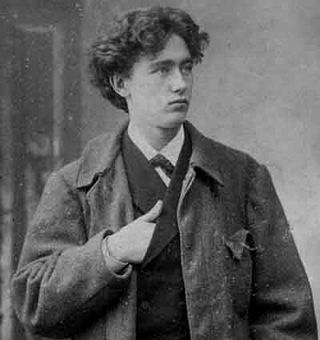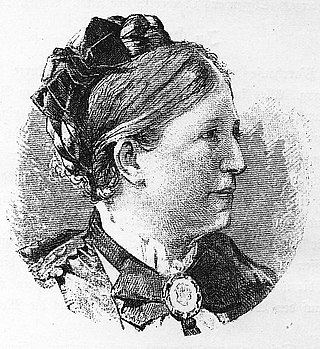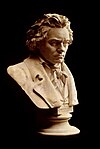Related Research Articles

A symphony is an extended musical composition in Western classical music, most often for orchestra. Although the term has had many meanings from its origins in the ancient Greek era, by the late 18th century the word had taken on the meaning common today: a work usually consisting of multiple distinct sections or movements, often four, with the first movement in sonata form. Symphonies are almost always scored for an orchestra consisting of a string section, brass, woodwind, and percussion instruments which altogether number about 30 to 100 musicians. Symphonies are notated in a musical score, which contains all the instrument parts. Orchestral musicians play from parts which contain just the notated music for their own instrument. Some symphonies also contain vocal parts.

Louis-Hector Berlioz was a French Romantic composer and conductor. His output includes orchestral works such as the Symphonie fantastique and Harold in Italy, choral pieces including the Requiem and L'Enfance du Christ, his three operas Benvenuto Cellini, Les Troyens and Béatrice et Bénédict, and works of hybrid genres such as the "dramatic symphony" Roméo et Juliette and the "dramatic legend" La Damnation de Faust.
Sir Donald Francis Tovey's Essays in Musical Analysis are a series of analytical essays on classical music. The essays came into existence as programme notes, written by Tovey, to accompany concerts given by the Reid Orchestra in Edinburgh. Between 1935 and 1939, they were published in six volumes as Essays in Musical Analysis. Each volume focused on a certain genre of orchestral or choral music, with many of the works discussed with the help of music examples. In 1944, a posthumous seventh volume appeared on chamber music. In 1989, a new version was published with some essays omitted and the remainder of Volumes I-VI consolidated into two volumes.

A piano concerto, a type of concerto, is a solo composition in the classical music genre which is composed for piano accompanied by an orchestra or other large ensemble. Piano concertos are typically virtuosic showpieces which require an advanced level of technique. Piano concertos are typically written out in music notation, including sheet music for the pianist, orchestral parts, and a full score for the conductor.
In Western classical music, obbligato usually describes a musical line that is in some way indispensable in performance. Its opposite is the marking ad libitum. It can also be used, more specifically, to indicate that a passage of music was to be played exactly as written, or only by the specified instrument, without changes or omissions. The word is borrowed from Italian ; the spelling obligato is not acceptable in British English, but it is often used as an alternative spelling in the US. The word can stand on its own, in English, as a noun, or appear as a modifier in a noun phrase.

Schroeder is a fictional character in the long-running comic strip Peanuts, created by Charles M. Schulz. He is distinguished by his prodigious skill at playing the toy piano, as well as by his love of classical music in general and the composer Ludwig van Beethoven in particular. Schroeder is also the catcher on Charlie Brown's baseball team, though he is usually seen walking back to the pitcher's mound with the baseball, never throwing it—admitting in one strip he did not want the other team to discover his lack of ability. He is also the object of the unrequited infatuation of Lucy Van Pelt, who constantly leans on Schroeder's piano. Charlie Brown, Frieda, Peppermint Patty, and Snoopy are occasionally depicted leaning on Schroeder's piano.

Freiherr Hans Guido von Bülow was a German conductor, pianist, and composer of the Romantic era. As one of the most distinguished conductors of the 19th century, his activity was critical for establishing the successes of several major composers of the time, especially Richard Wagner and Johannes Brahms. Alongside Carl Tausig, Bülow was perhaps the most prominent of the early students of the Hungarian composer, pianist and conductor Franz Liszt; he gave the first public performance of Liszt's Sonata in B minor in 1857. He became acquainted with, fell in love with and eventually married Liszt's daughter Cosima, who later left him for Wagner. Noted for his interpretation of the works of Ludwig van Beethoven, he was one of the earliest European musicians to tour the United States.
Sinfonia concertante is an orchestral work, normally in several movements, in which one or more solo instruments contrast with the full orchestra. It emerged as a musical form during the Classical period of Western music from the Baroque concerto grosso. Sinfonia concertante encompasses the symphony and the concerto genres, a concerto in that soloists are on prominent display, and a symphony in that the soloists are nonetheless discernibly a part of the total ensemble and not preeminent. Sinfonia concertante is the ancestor of the double and triple concerti of the Romantic period corresponding approximately to the 19th century.

Paul Felix Weingartner, Edler von Münzberg was an Austrian conductor, composer and pianist.
The "War of the Romantics" is a term used by some music historians to describe the schism among prominent musicians in the second half of the 19th century. Musical structure, the limits of chromatic harmony, and program music versus absolute music were the principal areas of contention. The opposing parties crystallized during the 1850s. The most prominent members of the conservative circle were Johannes Brahms, Joseph Joachim, Clara Schumann, and the Leipzig Conservatoire, which had been founded by Felix Mendelssohn. Their opponents, the radical progressives mainly from Weimar, were represented by Franz Liszt and the members of the so-called New German School, and by Richard Wagner. The controversy was German and Central European in origin; musicians from France, Italy, and Russia were only marginally involved.
James Ehnes, is a Canadian-American concert violinist and violist.

Hans Schmidt-Isserstedt was a German conductor and composer. After studying at several music academies, he worked in German opera houses between 1923 and 1945, first as a répétiteur and then in increasingly senior conducting posts, ending as Generalmusikdirektor of the Deutsche Oper Berlin.

Melinda O'Neal is a conductor of choral and choral-orchestral music, professor emerita of music, and author.

Ida Marie Lipsius, alias La Mara, was a German writer and music historian.

The New German School is a term introduced in 1859 by Franz Brendel, editor of the Neue Zeitschrift für Musik, to describe certain trends in German music. Although the term has frequently been used in essays and books about music history of the 19th and early 20th centuries, a clear definition is complex.

The Allgemeiner Deutscher Musikverein was a German musical association founded in 1861 by Franz Liszt and Franz Brendel, to embody the musical ideals of the New German School of music.
Alsatian conductor Charles Munch was one of the most widely recorded symphonic conductors of the twentieth century. Here is a partial list of his recordings.
Musical quotation is the practice of directly quoting another work in a new composition. The quotation may be from the same composer's work (self-referential), or from a different composer's work (appropriation).

Vladimir Abramovich Altschuler, also Altshuler, is a Russian chief-conductor and artistic director of Saint Petersburg Academic Symphony Orchestra and Honoured Artist of Russia.
The Lexicon of Musical Invective is an American musicological work by Nicolas Slonimsky. It was first published in 1953, and a second, revised, and expanded edition was released in 1965. The book is an anthology of negative musical critiques, focusing on classical music masterpieces and composers who are now regarded as greats, including Beethoven and Varèse.
References
Citations
- ↑ Barzun 1969, p. 76.
- ↑ Comini 2008, p. 249.
- 1 2 Slonimsky 1998 , p. 99
- ↑ Paul Green, "Bacharach's Back On Key After 10-Year Slump", Los Angeles Times, 13 July 1986
- ↑ Matthews 2013, p. 4.
- ↑ Robinson-Greene 2016, p. 42.
Sources
- Barzun, Jacques (1969). Hector Berlioz and the Romantic Century. Vol. II. New York: Columbia University Press.
- Comini, Alessandra (2008). The Changing Image of Beethoven. Santa Fe: Sunstone Press.
- Matthews, David (2013) [2003]. Britten (Centenary ed.). London: Haus Publishing. ISBN 978-1-908323-38-5.
- Robinson-Greene, Rachel (2016). "Rhapsody on a Theme by Schroeder". In Richard Greene; Rachel Robinson-Greene (eds.). Peanuts and Philosophy: You're a Wise Man, Charlie Brown!. Open Court. ISBN 9780812699531.
- Slonimsky, Nicolas (1998). Slonimsky's Book of Musical Anecdotes. New York: Schirmer.
